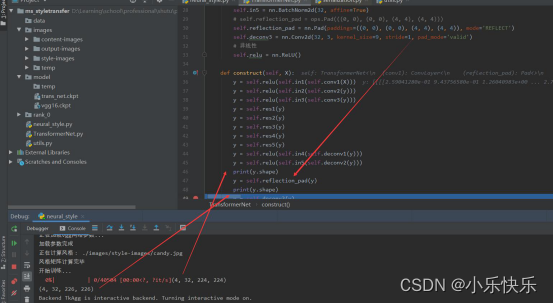问题描述:
mindspore.nn.Pad 输出异常
不小心把原问题删掉了。。。重新说明一遍
代码中self.reflection_pad函数不能正确对输入的数据进行填充,理论上应该输出【32,232,232】维度的数据 实际上输出了【32,226,226】的数据。
实际上使用了这个函数之后,训练时反向传播中也会报错。
【问题截图】

【代码】
import mindspore.nn as nnimport mindspore.ops as ops
class TransformerNet(nn.Cell):
def __init__(self):
super(TransformerNet, self).__init__()
self.conv1 = ConvLayer(3, 32, kernel_size=9, stride=1)
# self.in1 = nn.InstanceNorm2d(32, affine=True)
self.in1 = nn.BatchNorm2d(32, affine=True)
self.conv2 = ConvLayer(32, 64, kernel_size=3, stride=2)
# self.in2 = nn.InstanceNorm2d(64, affine=True)
self.in2 = nn.BatchNorm2d(64, affine=True)
self.conv3 = ConvLayer(64, 128, kernel_size=3, stride=2)
# self.in3 = nn.InstanceNorm2d(128, affine=True)
self.in3 = nn.BatchNorm2d(128, affine=True)
# Residual layers
self.res1 = ResidualBlock(128)
self.res2 = ResidualBlock(128)
self.res3 = ResidualBlock(128)
self.res4 = ResidualBlock(128)
self.res5 = ResidualBlock(128)
# Upsampling Layers
self.deconv1 = UpsampleConvLayer(128, 64, kernel_size=3, stride=1, upsample=2)
# self.in4 = nn.InstanceNorm2d(64, affine=True)
self.in4 = nn.BatchNorm2d(64, affine=True)
self.deconv2 = UpsampleConvLayer(64, 32, kernel_size=3, stride=1, upsample=2)
# self.in5 = nn.InstanceNorm2d(32, affine=True)
self.in5 = nn.BatchNorm2d(32, affine=True)
# self.reflection_pad = ops.Pad(((0, 0), (0, 0), (4, 4), (4, 4)))
self.reflection_pad = nn.Pad(paddings=((0, 0), (0, 0), (4, 4), (4, 4)), mode='REFLECT')
self.deconv3 = nn.Conv2d(32, 3, kernel_size=9, stride=1, pad_mode='valid')
# 非线性
self.relu = nn.ReLU()
def construct(self, X):
y = self.relu(self.in1(self.conv1(X)))
y = self.relu(self.in2(self.conv2(y)))
y = self.relu(self.in3(self.conv3(y)))
y = self.res1(y)
y = self.res2(y)
y = self.res3(y)
y = self.res4(y)
y = self.res5(y)
y = self.relu(self.in4(self.deconv1(y)))
y = self.relu(self.in5(self.deconv2(y)))
print(y.shape)
y = self.reflection_pad(y)
print(y.shape)
y = self.deconv3(y)
return y
class ConvLayer(nn.Cell):
def __init__(self, in_channels, out_channels, kernel_size, stride):
super(ConvLayer, self).__init__()
padding_size = kernel_size // 2
self.reflection_padding = ((0, 0), (0, 0), (padding_size, padding_size), (padding_size, padding_size))
self.reflection_pad = nn.Pad(paddings=self.reflection_padding, mode='REFLECT')
self.conv2d = nn.Conv2d(in_channels, out_channels, kernel_size, stride, pad_mode='valid')
def construct(self, x):
out = self.reflection_pad(x)
out = self.conv2d(out)
return out
class ResidualBlock(nn.Cell):
"""ResidualBlock
introduced in: https://arxiv.org/abs/1512.03385
recommended architecture: http://torch.ch/blog/2016/02/04/resnets.html
"""
def __init__(self, channels):
super(ResidualBlock, self).__init__()
self.conv1 = ConvLayer(channels, channels, kernel_size=3, stride=1)
# self.in1 = nn.InstanceNorm2d(channels, affine=True)
self.in1 = nn.BatchNorm2d(channels, affine=True)
self.conv2 = ConvLayer(channels, channels, kernel_size=3, stride=1)
# self.in2 = nn.InstanceNorm2d(channels, affine=True)
self.in2 = nn.BatchNorm2d(channels, affine=True)
self.relu = nn.ReLU()
def construct(self, x):
residual = x
out = self.relu(self.in1(self.conv1(x)))
out = self.in2(self.conv2(out))
out = out + residual
return out
class UpsampleConvLayer(nn.Cell):
"""UpsampleConvLayer
Upsamples the input and then does a convolution. This method gives better results
compared to ConvTranspose2d.
ref: http://distill.pub/2016/deconv-checkerboard/
"""
def __init__(self, in_channels, out_channels, kernel_size, stride, upsample=None): # upsample
super(UpsampleConvLayer, self).__init__()
self.upsample = upsample
if upsample:
self.upsample_layer = nn.ResizeBilinear()
padding_size = kernel_size // 2
reflection_padding = ((0, 0), (0, 0), (padding_size, padding_size), (padding_size, padding_size))
self.reflection_pad = nn.Pad(paddings=reflection_padding, mode='REFLECT')
self.conv2d = nn.Conv2d(in_channels, out_channels, kernel_size, stride, pad_mode='valid')
def construct(self, x):
x_in = x
if self.upsample:
x_in = self.upsample_layer(x_in, scale_factor=self.upsample)
out = self.reflection_pad(x_in)
out = self.conv2d(out)
return out解答:
ops.pad算子是不支持reflect模式的,想要实现symmetric或者reflect模式请使用ops.mirrorpad算子。





















 6354
6354











 被折叠的 条评论
为什么被折叠?
被折叠的 条评论
为什么被折叠?








